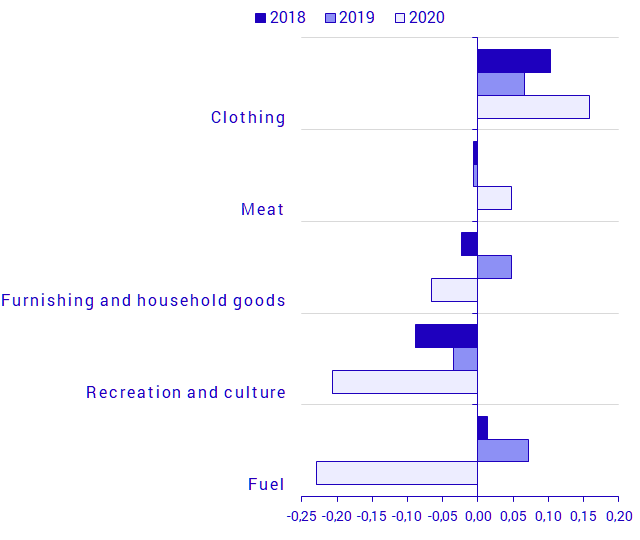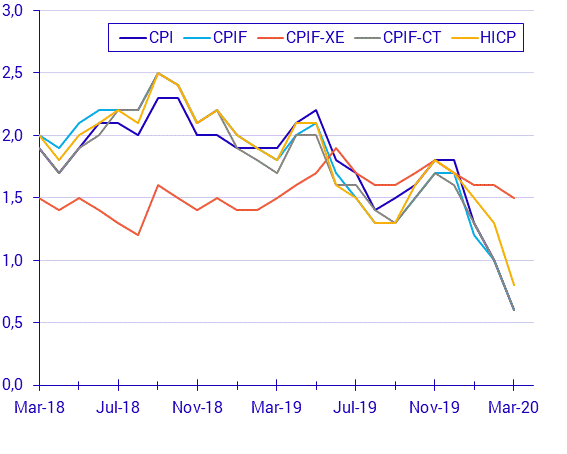Consumer Price Index (CPI), March 2020
Inflation rate according to CPIF was 0.6 percent in March 2020
Statistical news from Statistics Sweden 2020-04-15 9.30
The inflation rate according to the CPIF (Consumer Price Index with fixed interest rate) was 0.6 percent in March 2020, down from 1.0 percent in February. The change on a monthly basis between February and March was -0.2 percent.
In brief
| Index Numbers | Monthly changes, percent | Annual changes, percent | |
|---|---|---|---|
| CPI (1980=100) | 333.91 | ‑0.2 | 0.6 |
| CPIF (1987=100) | 218.28 | ‑0.2 | 0.6 |
| CPIF-XE (1987=100) | 206.83 | 0.2 | 1.5 |
- Lower electricity and fuel prices together affected the inflation rate by -0.8 percentage points.
- Some prices were missing toward the end of the month - for some groups the price development represents the first weeks of the month.
Fuel and clothes affected the CPIF in March
The CPIF fell by 0.2 percent between February and March. In the corresponding period a year ago, the CPIF increased by 0.2 percent.
The main contribution to the monthly rate came from lower prices on fuel. Lower prices on electricity, equipment and household goods, package holidays, as well as recreational goods, such as books and sporting goods also affected the CPIF.
Higher prices on food, clothes and international air travel offset the price decreases.
The table below shows changes on a monthly basis and effects on the CPIF based on the goods and services that had the largest effect on the CPIF in March 2020. The results are reported per COICOP category; COICOP refers to the United Nations classification of household consumption expenditure.
| NamnENG | Monthly changes, percent | Monthly effect on the CPIF, percentage points |
|---|---|---|
| Food (01.1) | 1.2 | 0.1 |
| Clothing (03.1) | 4.5 | 0.2 |
| Electricity (04.5.1) | ‑2.7 | ‑0.1 |
| Furnishings and household goods (05) | ‑1.0 | ‑0.1 |
| Fuel (07.2.2) | ‑9.0 | ‑0.2 |
| Transport services (07.3) | 2.9 | 0.1 |
| Other recreational items (09.3) | ‑2.8 | ‑0.1 |
| Newspapers, books and stationary (09.5) | ‑5.1 | ‑0.05 |
| Package holidays (09.6) | ‑8.3 | ‑0.1 |

Seasonal patterns and temporary price changes
Price changes for goods and services may be seasonal or temporary. The figure above shows effects on a monthly basis for the goods and services that differ most compared with the corresponding month a year ago. Fuel prices fell in March 2020, while in the same period a year ago, these prices rose. This generates “base effects”, which lowers the inflation rate.
Contribution to inflation rate in March
The inflation rate according to the CPIF, that is, the change in the CPIF over the past 12-month period, was 0.6 percent in March 2020, down from 1.0 percent in February.
The largest contribution to the inflation rate in March 2020 came from higher prices on food, international air travel, and restaurants. Price decreases on electricity, fuel and telecommunications equipment offset this increase.
| Yearly change, percent | Yearly change effect, percentage points | |
|---|---|---|
| Food (01.1) | 2.5 | 0.3 |
| Electricity (04.5.1) | ‑13.3 | ‑0.6 |
| Rented and housing co-operative dwellings: rent incl. heating (04.S) | 1.5 | 0.2 |
| Housing (04.x) | 2.9 | 0.2 |
| Fuel (07.2.2) | ‑8.3 | ‑0.2 |
| Transport services (07.3) | 7.9 | 0.2 |
| Telephone equipment (08.2) | ‑15.7 | ‑0.2 |
| Restaurants (11.1) | 2.8 | 0.2 |
Other measures of inflation
Statistics Sweden uses different inflation measures for different purposes. The CPIF is the Riksbank’s target variable, while the CPI is the measure used for purposes of compensation.

Information about the coronavirus pandemic
The quality of the price data for the CPI for March is not considered to have been affected to any greater extent by the coronavirus outbreak. A majority of the prices were collected before access to certain goods and services became limited. For package holidays and air travel, cancelled flights were excluded from the calculations; consequently the price development for these indices represents the first weeks of March. For further information about any future measurement problems, see the link below.
Calculation inflation harder during the coronavirus pandemic
Definitions and explanations
The CPIF shows the same price trend as the CPI, but without the direct effects of a changed monetary policy. The CPIF is the Riksbank’s target variable for the inflation target.
The CPIF excluding energy (CPIF-XE) and the CPIF with constant tax (CPIF-CT) are two other measures of inflation produced by Statistics Sweden on behalf of the Riksbank. In the CPIF-XE, energy products are excluded from the CPIF, while in the CPIF-CT the taxes and subsidies associated with the products in the CPIF are kept constant.
The HICP (Harmonised Index of Consumer Prices) is produced by all EU Member States. This measure has a somewhat smaller coverage than the CPI and the CPIF, mainly because parts of households’ housing costs are omitted.
Next publishing will be
2020-05-13 at 9:30.
Statistical Database
More information is available in the Statistical Database
Feel free to use the facts from this statistical news but remember to state Source: Statistics Sweden.
